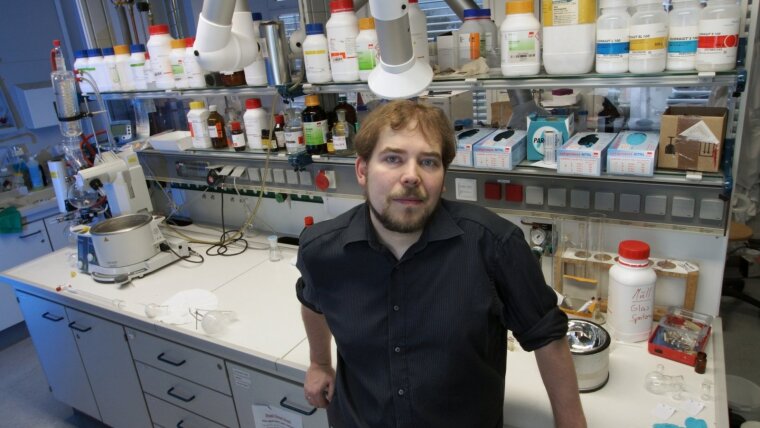
Prof. Dr. Felix Schacher
Image: PrivateProf. Dr. Felix SCHACHER
Email: felix.schacher@uni-jena.de
Phone: +49 3641-9-48250
Since 2010, Prof. Schacher’s research group at the Friedrich Schiller University Jena operates at the interface of organic, physical, and macromolecular chemistry. He is also a member of the Jena Center for Soft Matter (JCSM) and active in the Sections Makromolekulare Chemie and Chemie des Waschens of the German Chemical Society (GDCh).
Research Areas
We are interested in the self-assembly and application of polymeric materials at different length scales from 1 nm up to several µm. This involves the synthesis and characterization of innovative and functional polymers and block copolymers. To achieve this, we utilize different polymerization techniques, ranging from conventional free radical to ionic methods. Research interests include:
- controlled/ living polymerization techniques
- stimuli-responsive block copolymer membranes
- hierarchy and compartmentalization in block copolymer materials
- design and manipulation of interfaces, in particular within organic/inorganic hybrid materials
- morphological investigations using a combination of imaging and scattering techniques
Teaching Fields
Our teaching includes various aspects of macromolecular chemistry. He gives courses in:
- the fundamentals of polymer chemistry
- the synthesis and characterization of block copolymers
- self-assembly and supramolecular chemistry
- polymers in materials science
Research Methods
Prof. Schacher’s research group utilizes different methods for the synthesis and morphological characterization of block copolymers which include:
- State-of-the-art synthetic equipment, including gloveboxes for working under inert conditions or under controlled temperature/humidity
- Dynamic and static light scattering (DLS/ SLS)
- Small and wide angle x-ray scattering (SAXS/ WAXS)
- Equipment for UV irradiation
- (Cryo)ultramicrotome for sample preparation in electron microscopy
Recent Research Results
We demonstrated that multicompartment micelles of about 150-200 nm size from stimuli-responsive triblock terpolymers, polybutadiene-block-poly (methacrylic acid)-block-poly (N,N-(dimethylamino) ethyl methacrylate) (BMAAD), are promising candidates for non-viral gene delivery into different cell lines. The structures exhibit a patchy shell, consisting of amphiphilic (interpolyelectrolyte complexes, MAA and D) and cationic patches (excess D), generating a surface reminiscent to those of certain viruses and capable of undergoing pH-dependent changes in charge stoichiometry. After polyplex formation with plasmid DNA, superior transfection efficiencies can be reached for both adherent cells and human leukemia cells. Compared to the gold standard PEI, remarkable improvements and a number of advantages were identified for this system, including increased cellular uptake and an improved release of the genetic material, accompanied by fast and efficient endosomal escape. Furthermore, high sedimentation rates might be beneficial regarding in vitro applications [1].
In another study, we use thiol-terminated, polyetherbased amphiphilic block copolymers with a hydrophilic poly(ethylene oxide) (PEO) segment and a second rosslinkable block of either poly(furfuryl glycidyl ether) (PFGE) or poly(allyl glycidyl ether) (PAGE) as ligands for Au nanoparticles. In both cases, direct reduction of suitable precursors in N,N-dimethylacetamide (DMAc) leads to Au NPs with a block copolymer shell which can be crosslinked using either Diels–Alder reactions for the PFGE segment or hydrosilylation chemistry targeting the PAGE segment. In this way, shellcrosslinked Au-NPs with enhanced stability against ligand exchange reactions in the presence of competitive ligands like alkyl thiols could be prepared [2]. Besides ligands, we also design polymeric templates for metal and metal oxide nanoparticles, e.g. where net charge and charge density of the template determines nanoparticle composition [3]. Further, we use amphiphilic diblock terpolymers for the preparation of free-standing integral asymmetric membranes via nonsolvent induced phase separation (NIPS) processes. The diblock terpolymers consist of a hydrophobic poly(styreneco-isoprene) block and a hydrophilic segment of poly(N,Ndimethylaminoethyl methacrylate). The materials are synthesized either via nitroxide mediated polymerization or living anionic polymerization. The NIPS process is used for the fabrication of porous diblock terpolymer membranes where the membrane morphology can be influenced by several parameters such as the applied solvent mixture, open time, or relative humidity. The resulting anisotropic membranes exhibit pH- and temperature-dependent water flux and pore sizes. UV-induced crosslinking of the isoprene part of the membrane matrix can be used to enhance membrane stability against solvents or to simply improve handling [4]. One intriguing application field for such materials is heterogeneous (photo) catalysis, as we could recently show for oxidation of thiophene under flow conditions [5] or photocatalytic hydrogen evolution after immobilization of catalytically active polyoxometalates and/or photosensitizers [6].
[1] Rinkenauer et al., ACS Nano 7, 9621 (2013).
[2] Hörenz et al., Polym. Chem. 6, 5633 (2015).
[3] Max et al., Macromolecules 53, 4511 (2020).
[4] Hörenz et al., Adv. Mater. Interfaces 2, 150042 (2015).
[5] Romanenko et al., J. Mater. Chem. A 5, 15789 (2017).
[6] Romanenko et al., J. Mater. Chem. A 8, 6238 (2020).
